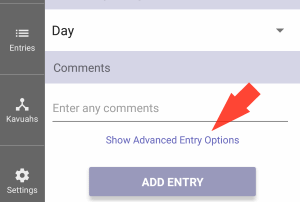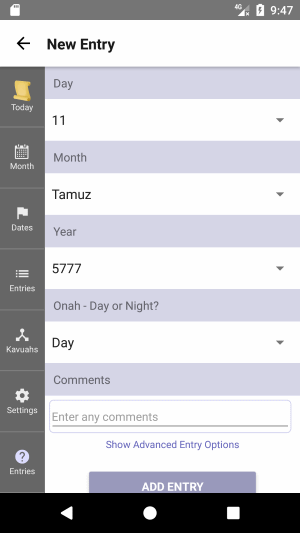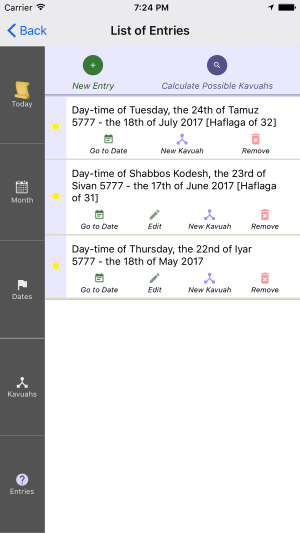

In Luach, an Entry is a euphemism for a period. (The Halachic term for a period is a "seeing" - ראיה).
Entries are the most basic piece of information that needs to be retained in order to keep a valid Halachic calendar.
The goal of keeping track of entries is threefold:
Luach uses the list of Entries to automatically calculate the Flagged Dates and possible Kavuahs.
The day, month and year of the Jewish Date for the beginning of the period.OnahWhen adding a new Entry, Luach allows you to select the date by either Jewish or Secular date.
When setting an Entry date by selecting a Secular date, please keep in mind that the Jewish Date changes at sunset while the Secular date does not change until midnight.
This may cause the incorrect Jewish date to be selected.
To help with this, on the New Entry Screen, Luach will show you what time sunset is for your location.
Each Jewish day is divided into two "Onahs"; the Night Onah and the Day Onah.HaflagaIf the period began between sunset and sunrise, the Entry is considered to have occurred during the Night Onah. If it began between sunrise and sunset, it is considered to have occurred during the Day Onah.
Luach is able to give you the time of sunset and sunrise for any location around the globe for any date. Make sure that you have selected your current location on the Settings Screen, and that your device has the correct time and time zone for your location.
If the time of the start of the period is very close (within about 13 minutes) of the sunset or sunrise time, it is strongly advisable to contact your Rav to help determine the correct date and Onah for that Entry.
The Haflaga is the number of days (or partial days) between the previous Entry and this one. Upon the addition of an Entry, Luach automatically works out the Haflaga from the previous Entry.
It is very important to note that not every seeing is considered a Halachic Vesset Entry.
For example, staining and the like are usually not considered Halachic Entries even those that
require the Niddah restrictions.
Any seeing is not a regular monthly period, needs Rabbinic determination whether or not to record
it as a regular Entry.
 In Luach, when an
Entry is added, by default, it is assumed to be a regular period. In cases where it was determined that
it should not be recorded as a regular Entry, Luach has two special options that can be set for each
Entry.
In Luach, when an
Entry is added, by default, it is assumed to be a regular period. In cases where it was determined that
it should not be recorded as a regular Entry, Luach has two special options that can be set for each
Entry.
On the New Entry Screen, just above the "Add Entry" button, press on "Show Advanced Entry Options".
Two special advanced options will appear that can be set for this Entry:
Whenever an Entry is added or changed, Luach looks over the list of Entries to check for one of the following.
A Vesset Kavuah is a Halachic term describing when a women has multiple periods in a recurring pattern."Broken" Kavuah Pattern
When a women has a set pattern, it is expected that periods will continue to occur in this pattern. This is until the pattern has been proven to have "broken".
Kavuah setting and breaking is a very complex Halachic issue and should aways be accompanied with Rabbinic guidance.
There are many ways that recurring periods can be considered to have occurred in a pattern.
Luach automatically calculates and suggests possible Kavuhas whenever an Entry is added or updated.
If a possible Kavuah is found, Luach will show The Possible Kavuah Screen.
See the Kavuah documentation page for more details about Kavuahs.
The same way that a pattern of Entries sets a Kavuah, a set of Entries that does not match the Kavuah can "break" the Kavuah pattern."Re-awakened" Kavuah Pattern
If there was a Kavuah pattern set previously and is still Active, Luach will check to see if this Entry has "broken" that Kavuahs pattern.
If there is a Kavuah found that Luach thinks may have been broken by this Entry, you will be asked if you want to set that Kavuah to not active.
A Kavuah that is not active does not set any Flagged Dates.
Once again, Kavuah setting and breaking is a very complex Halachic issue and should aways be accompanied with Rabbinic guidance.
For many Kavuah types, even if the Kavuah pattern was "broken" by a set of Entries that were out of pattern, they can be reawakened again with a single Entry that matches the original pattern."Out of Pattern" for a "Canceling" Kavuah
So, whenever an Entry is added or changed, Luach will check to see if this Entry matches the pattern for any inactive Kavuahs.
If one is found, Luach will ask if you wish to set this Kavuah to Active.
Once again, Kavuah setting and breaking is a very complex Halachic issue and should aways be accompanied with Rabbinic guidance.
If there is a Kavuah that is active and that is set to Cancel Onah Beinonis, whenever an Entry is added or edited, Luach checks to assure that the new Entry is not "Out of Pattern".
If the new Entry does not match the pattern set by the Kavuah, Luach will ask if you wish to remove the Cancel Onah Beinonis property for that Kavuah.
 The New Entry Screen
The New Entry Screen
The list of Entries that have been added can be viewed from the Entries List Screen.
In the Entry List, the Entries are shown sorted to show the most recent Entries on top and the oldest ones on the bottom.
To assist in giving a glancing overview of the Entry list trends, each Entries background color (dark or light) is set according
to which Onah it occurred in.
The icon shown by each Entry is also either a sun or a moon according to the Entries Onah.
Each Entry has the following option buttons:
Pressing this will take you to the Jewish calendar date when the Entry started.Edit
This will take you to the Edit Entry Screen, to change any of the Entry's properties (including the advanced ones).New Kavuah
This option will not be shown for an Entry that is the Setting Entry for a Kavuah.
This will take you to the New Kavuah screen to add a new Kavuah.Remove
For this new Kavuah, this Entry will be used as it's Setting Entry.
This will totally remove this Entry from the list.
Once removed, it is gone. The only way to add it again, is to add it as a New Entry.
If any Kavuahs have this Entry set as their Setting Entry these Kavuahs will be removed as well.
Before deleting any Entries or Kavuahs, Luach will ask you to confirm the removal.
 The Entry List Screen
The Entry List Screen